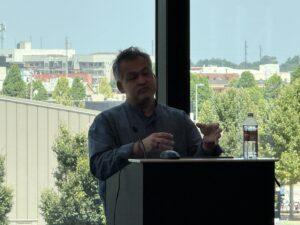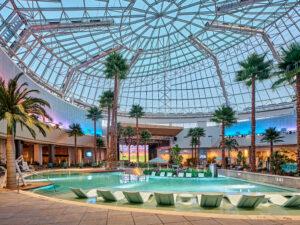 By Ray Mabry, AIA | Principal & Dallas Office Leader, HBG Design | Member, Citizen Potawatomi Nation
By Ray Mabry, AIA | Principal & Dallas Office Leader, HBG Design | Member, Citizen Potawatomi Nation
Couldn’t make it to my session at OIGA 2025? No worries—I’m recapping the key takeaways on tribal casino expansion and smart resort growth strategies right here.
When we talk about tribal casino expansion and resort development, we’re not just talking about new construction—we’re talking about legacy. For tribal nations, each expansion project carries long-term implications, shaping communities and economies for generations. That’s why smart expansion planning must be guided by data, rooted in cultural values, and driven by a clearly defined economic vision.
At HBG Design, we’ve helped tribal clients across the country navigate every stage of the expansion process, from master planning to construction to grand opening. What we’ve learned: successful growth doesn’t happen by accident. Casino expansion takes strategy. It takes discipline. And it requires an aligned, experienced team working from a unified vision.
When it’s time to grow, these are the expansion insights worth keeping close:
✔ Long-term, generational vision
✔ A master plan rooted in feasibility and customer data
✔ Aligned teams from day one
✔ Smart phasing that leverages revenue
✔ Operational continuity during construction
✔ Seamless guest experience
✔ Cohesive brand expression
From “Slot Halls” to Super-Regional Destinations
Across the country, we’re seeing a clear evolution: tribes are transforming compact, gaming-focused venues into full-fledged destination resorts that compete on the national stage. Guests don’t need to fly to Vegas anymore. They’re looking for upscale, high-touch experiences closer to home. That’s a huge opportunity, especially in markets like Dallas/Fort Worth.
WinStar World Casino Resort in Thackerville, Oklahoma, about 90 minutes from the DFW market, is a prime example. What began as tent gaming and a supporting hotel has grown into a 12,000+ machine, multi-hotel, entertainment-packed mega-resort. Every move—whether it was efficiently positioning non-gaming amenities off-trust to maximize the trust footprint or phasing infrastructure upgrades—was driven by long-term planning. And that kind of future-focused thinking continues to pay off.

Learn from the Past. Plan for the Future.
Not every property starts fresh. Many tribal projects come with inherited issues—aging infrastructure, dated additions, and lack of long-term phasing. That’s where we roll up our sleeves. HBG teams help our clients untangle those complexities—from reworking site sequencing, opening sight lines to revenue-generating spaces, and modernizing infrastructure so it supports what’s next.
Expansion is our chance to fix what’s not working and create something that lasts.
A Master Plan Built for the Long Haul
Our approach to master planning is grounded in data and adaptability. We always start with feasibility studies, market demand, and customer trends. It’s how we know what’s viable now, and what will pay off five phases from now.
One of the best examples of strategic planning and phasing is Gun Lake Casino Resort in Michigan. That project didn’t happen all at once. It was phased carefully over time. But the vision was always clear: become a premier resort destination.
That’s how Wawyé Oasis came to life. What started as an Owner concept grew into a fully enclosed, all-season pool and event venue. The HBG team took our experience designing large-scale, climate-controlled atriums like those at Gaylord Texan and Palms Resorts and created something iconic, efficient, and uniquely suited to Gun Lake’s brand.
And because we respected the existing material palette while enhancing it, the old and new spaces now feel completely cohesive. That’s good design, and it keeps working long after the grand opening.

Guests Feel the Disconnect—So Fix It Before They Do
You can have the flashiest new expansion in the world, but if it doesn’t connect with the rest of the property, guests will notice, and not in a good way. Disjointed spaces dilute the brand and disrupt the flow of the experience.
That’s why we never treat expansions like standalone projects. We zoom out and look at the full property story. For many tribal resorts, that means addressing inherited quirks, for example, outdated infrastructure, awkward additions, or site plans that don’t quite add up. We help bring clarity by reworking circulation, upgrading aging systems, and opening up sight lines to showcase the amenities that drive revenue.
We’ll also typically recommend setting aside 5–10% of the FF&E budget to refresh adjacent spaces during expansion. Just a few updates to lighting, finishes, and furnishings can bring everything into harmony. At Gun Lake, this strategy helped us unify the new hotel and entertainment venues with the existing gaming floor, making the whole property feel seamless and elevated.
Align Early. Avoid Surprises. Build Smarter.

But one of the biggest cost drivers I see? Misalignment between stakeholders. If your design, construction, and operations teams aren’t aligned from the beginning, you’re most likely going to hit delays, budget issues, and rework.
Early integration into the process is always a good idea. We build collaborative workflows. We align schedules. And we make sure that all voices and perspectives are at the table from day one. That’s how we keep vision, program, and design intent as the roadmap, timelines on track, and help protect the project’s bottom line—setting the entire project up for smarter, more efficient delivery.
Phase with Purpose. Protect the Guest Experience.
This rule is simple: never let construction get in the way of your guests. If you lose satisfaction and revenue during the build, you’re working against the very success you’re trying to create. Smart phasing keeps the heart of your property beating while setting the stage for what’s next.
Phasing isn’t just a construction strategy, it’s a critical part of protecting your operation and your bottom line. That’s why we develop detailed, team-driven phasing plans to keep key spaces open, maintain guest flow, and ensure revenue keeps rolling in.
The Takeaway: Expansion Is Legacy
There’s no one-size-fits-all formula for expansion design. But when you begin with the right questions—and plan intentionally for where you want to be 10 to 20 years from now—expansion becomes something greater. It becomes transformation.
Because in the end, success isn’t just about what opens tomorrow. It’s about what still delivers value a decade down the line. And that’s the kind of legacy we’re here to create.
